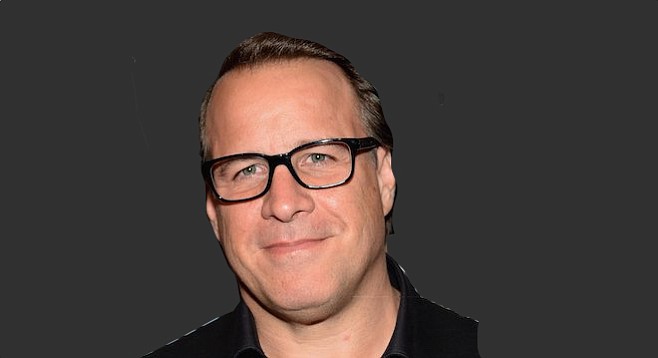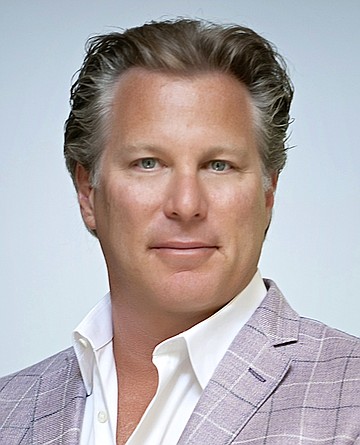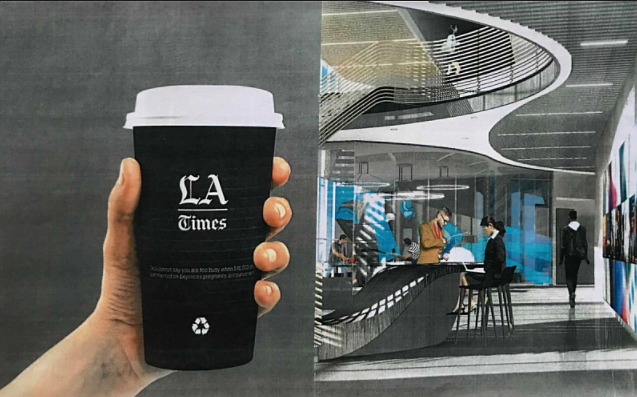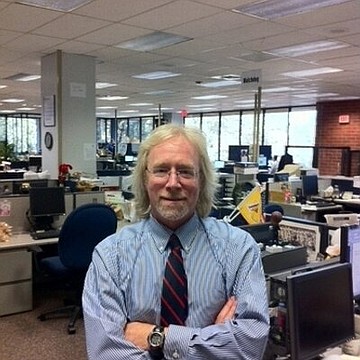 Facebook
Facebook
 X
X
 Instagram
Instagram
 TikTok
TikTok
 Youtube
Youtube

Chicago wheeler-dealer Michael Ferro's tronc, which has been shrinking the staff and newsroom space of the San Diego Union-Tribune, is encountering resistance from Los Angeles Times staffers, worried about putative plans to move the U-T’s big sister from downtown L.A. to somewhere in the metro area's upscale western reaches.

"Tronc is actively looking at the Westside as a possible future location for our newsroom, according to several well-connected sources," per a January 10 blog post by the Los Angeles Times Guild, the labor union seeking to represent the paper's staff.
"Santa Monica, Playa del Rey (perhaps Playa Vista) have been floated as prospective addresses. We have also obtained an older proposal for Tronc’s plan to move our newsroom to the Aon building downtown."
When the union attempted to confer with Times publisher Ross Levinsohn, it was rebuffed, says the post.
"We voiced concern that a move out of downtown — our address since the founding of the paper — could seriously impact our news gathering and newsroom budget, as well as the commutes of hundreds of Times staffers. We asked Ross to meet with us and include the newsroom in discussions. He declined."

Said the guild in its email to Levinsohn, "Westside communities — such as Santa Monica and Playa del Rey — are wonderful places to live and important to our news coverage. But relocating to that area would make our jobs more challenging and nearly double the commute times of the average staffer.
"Downtown is the most central location to many of the communities and institutions that are vital to our daily reporting, including city, county, state and several federal government offices, big financial houses and law firms, and centers of culture and sport, such as the Music Center, a cluster of major museums, the Staples Center and Dodger Stadium."

The union was even less impressed by a proposal to relocate the Times to a luxury downtown office tower known as the Aon building.
"First, it seemed to devote a lopsided amount of space and expense to lavish, penthouse accommodations for executives — including a game room and tricked-out helipad," noted the email.
"Second, the proposal placed the journalists who produce The Times in cramped quarters poorly designed for the work we do. We appeared to have been sardined at communal work tables, rather than given individual spaces. Temporary work tables do not lend themselves to the craft and art of conducting interviews (often on sensitive topics), poring over stacks of documents, writing stories and jamming on deadline. Other features of the proposal are dated and gimmicky — the genius bar and branded uniforms among them."

Unlike their brethren in Los Angeles, Union-Tribune staffers have thus far made no effort to organize, and most remain mum in public about their declining ranks, though one appears to have a dark sense of humor about persistent reports of U-T shrinkage, possibly leading to its ultimate demise as a free-standing paper.
"That settles it. Heralded or not, I'm making a racket when I go (provided it's not feet first)," tweeted columnist Michael Smolens following a January 10 report here about the departure of investigative reporter James DeHaven, bringing the count of the paper's so-called watchdog reporters per its online staff list down to three.


Chicago wheeler-dealer Michael Ferro's tronc, which has been shrinking the staff and newsroom space of the San Diego Union-Tribune, is encountering resistance from Los Angeles Times staffers, worried about putative plans to move the U-T’s big sister from downtown L.A. to somewhere in the metro area's upscale western reaches.

"Tronc is actively looking at the Westside as a possible future location for our newsroom, according to several well-connected sources," per a January 10 blog post by the Los Angeles Times Guild, the labor union seeking to represent the paper's staff.
"Santa Monica, Playa del Rey (perhaps Playa Vista) have been floated as prospective addresses. We have also obtained an older proposal for Tronc’s plan to move our newsroom to the Aon building downtown."
When the union attempted to confer with Times publisher Ross Levinsohn, it was rebuffed, says the post.
"We voiced concern that a move out of downtown — our address since the founding of the paper — could seriously impact our news gathering and newsroom budget, as well as the commutes of hundreds of Times staffers. We asked Ross to meet with us and include the newsroom in discussions. He declined."

Said the guild in its email to Levinsohn, "Westside communities — such as Santa Monica and Playa del Rey — are wonderful places to live and important to our news coverage. But relocating to that area would make our jobs more challenging and nearly double the commute times of the average staffer.
"Downtown is the most central location to many of the communities and institutions that are vital to our daily reporting, including city, county, state and several federal government offices, big financial houses and law firms, and centers of culture and sport, such as the Music Center, a cluster of major museums, the Staples Center and Dodger Stadium."

The union was even less impressed by a proposal to relocate the Times to a luxury downtown office tower known as the Aon building.
"First, it seemed to devote a lopsided amount of space and expense to lavish, penthouse accommodations for executives — including a game room and tricked-out helipad," noted the email.
"Second, the proposal placed the journalists who produce The Times in cramped quarters poorly designed for the work we do. We appeared to have been sardined at communal work tables, rather than given individual spaces. Temporary work tables do not lend themselves to the craft and art of conducting interviews (often on sensitive topics), poring over stacks of documents, writing stories and jamming on deadline. Other features of the proposal are dated and gimmicky — the genius bar and branded uniforms among them."

Unlike their brethren in Los Angeles, Union-Tribune staffers have thus far made no effort to organize, and most remain mum in public about their declining ranks, though one appears to have a dark sense of humor about persistent reports of U-T shrinkage, possibly leading to its ultimate demise as a free-standing paper.
"That settles it. Heralded or not, I'm making a racket when I go (provided it's not feet first)," tweeted columnist Michael Smolens following a January 10 report here about the departure of investigative reporter James DeHaven, bringing the count of the paper's so-called watchdog reporters per its online staff list down to three.
Comments